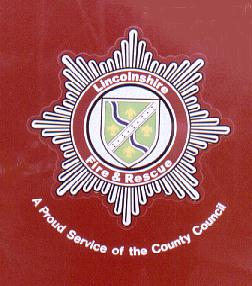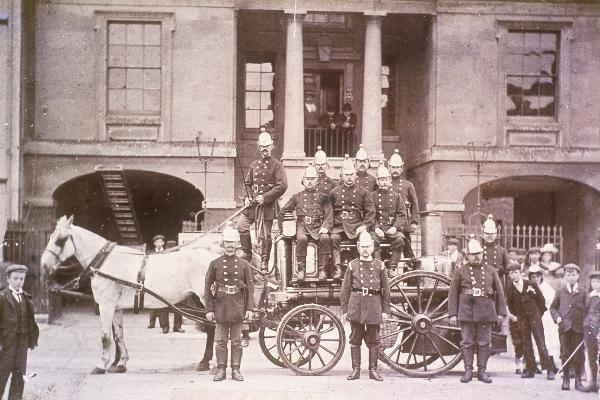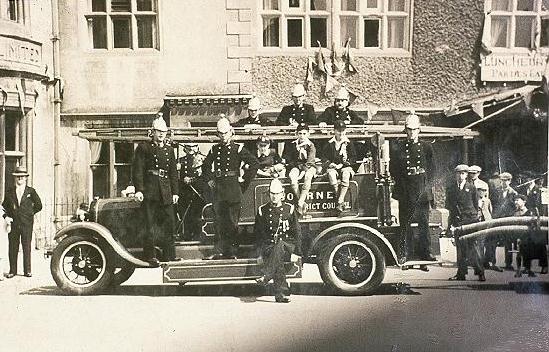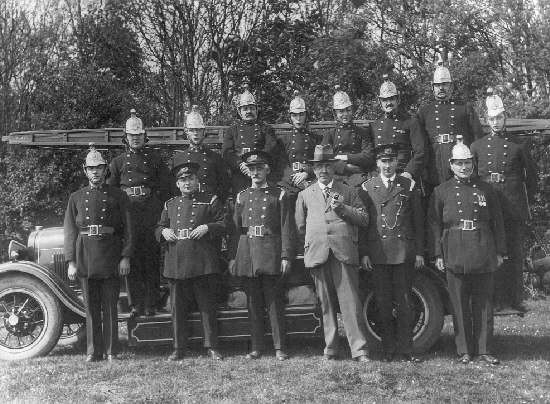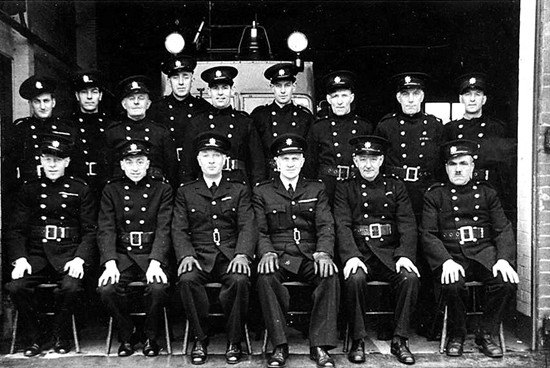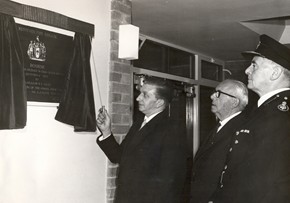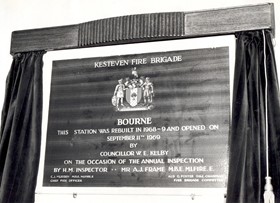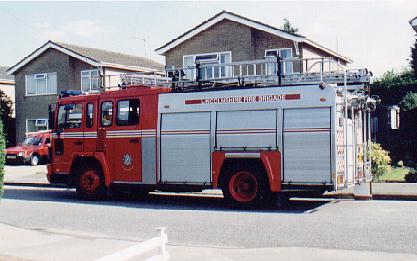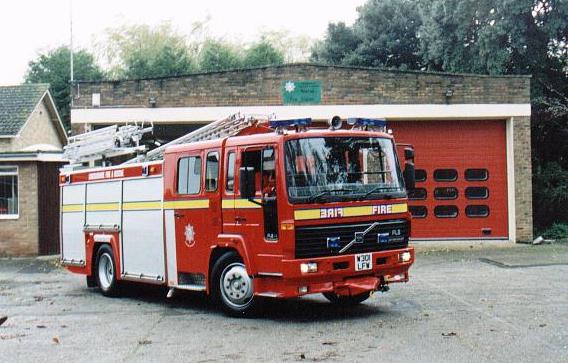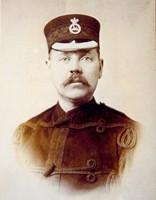The first historical
reference to a fire brigade relates to China in 4,000 B C while Egypt had an organisation for fighting fires in 2,000 B C and the Romans started to form theirs around 150 B C and these were highly trained and efficient units. There is no record of very early fire brigades in England although legislation in 1189 encouraged the use of fire-resistant building materials and in 1212 it was decreed that new houses were not to be roofed with reeds, rushes, straw or stubble and that water should be kept close by for fire fighting purposes. The system then, is by no means new. On Wednesday last, a fire broke out on the premises of Mr Charles Brand, publican, Pinfold Lane [the Marquess of Granby]. The stables and shed were burnt down, but through the able exertions of several neighbours, the adjoining premises were saved. The fire engine was in attendance, but owing to the length of time lost in fixing, and the defective state of the pipes, little service was rendered. The cause of the fire is yet unknown. In 1874, an Act of Parliament transferred responsibility for its upkeep to the Vestry Meeting which was then in charge of parish affairs, empowering the overseers of the poor to finance its future upkeep out of the local rate. The new arrangement was adopted by the meeting on Monday 27th April that year when it transpired that the existing fire engine was forty years old and in a poor condition. The meeting was told that when starting the engine, some of the valves did not work satisfactorily while all of the fire buckets were worn out and several of the pipes leaked. A fire brigade committee was appointed consisting of the churchwardens, the overseers of the poor and the officials of the various insurance companies in the town, and their first task was to order a detailed report with a view to having repairs carried out on the appliance and equipment in order that they were brought up to standard immediately. A second horse-drawn steam powered fire engine
was purchased to supplement the manual pump and on Saturday 24th March
1877, the Grantham Journal reported: "On Tuesday of last week, the fire
brigade went out for their quarterly practice taking both engines. The wood etc
had been in the fire box of the steam engine since last practice but within
eleven minutes from igniting, 100 lbs. pressure of steam was up. The engine was
worked an hour during which time it consumed one cwt. of coal and discharged 200
gallons of water per minute, reaching a height of almost 100 feet. Both engines
were considered to be in good working order."
In 1900, the council bought a horse drawn steam pump manned by twelve volunteers and capable of delivering two or more jets and firemen proudly posed outside the Town Hall with the appliance wearing smart new uniforms with brass helmets, leather belts and boots. The pair of grey horses used to pull the appliance were stabled in the yard of the Bull public house next door, now the Burghley Arms, and were shared by local undertakers who also used them for their hearse. The arrangement may seem primitive by today’s standards but it worked and we have a first-hand description from the Stamford Mercury of Friday 14th August 1903 when reporting a haystack fire in the North Fen at Bourne: News of the outbreak was brought to Bourne by messenger on horseback shortly before ten o’clock on Sunday morning. An alarm was at once raised by means of the fire bell and in a very short time the members of the brigade assembled for duty at the station under the command of Captain F Clarke. The engine was promptly horsed with steeds from the Bull Inn hostelry and soon on the road to the North Fen. Almost three miles journey brought the brigade to the scene of the fire on a farm occupied by Mr J Cooke. A new stack of hay was found ablaze, caused no doubt through spontaneous combustion as the fire appeared to be confined to the middle of the pile. Already many willing helpers had thrown a quantity of water on the burning heap and the firemen supplemented this with a plentiful supply, razed the stack to the ground and turned the hay over but the whole lot had been rendered useless, resulting in a heavy loss to the owner. There was a fairly strong wind blowing in the direction of the adjoining buildings at the time but thanks to the efforts of the brigade who got through their work in an expeditious manner, no damage was done to these premises. The appliance operated efficiently for the next few years but problems with the water pressure became apparent in the summer of 1907 when it was sent back to the makers, Merryweather and Sons Ltd of London, for maintenance and repairs at a cost of £225. When it was returned three months later, firemen put it through its paces and a report on the proceedings decided that the trials gave general satisfaction and added: "With one jet working, the water was forced through a full length of hose as high as the church steeple. With two jets, it was thrown higher than any house in the town whilst with three jets, it would reach the first storey of any dwelling house or the top of any ordinary farm stack." Overall, the brigade appears to have been extremely efficient and a tribute to the work they did was paid by James Baxter Shilcock, a senior member of Bourne Urban District Council and himself a former chief officer, during a speech at the annual fire brigade dinner held at the Nag's Head Hotel on Wednesday 14th October 1908. "I believe that we possess one of the best fire brigades in the county", he said. "I have on more than one occasion timed the brigade when they turned out and on a market day they have accomplished it in 11 minutes. I believe that the brigade can always be relied upon to do their duty." Improvements
in equipment followed and in 1928, a
Dennis trailer pump was purchased and this was towed by a lorry borrowed from T W Mays and Son, the local firm of
fellmongers. When there was a blaze, firemen were summoned to duty by a brass fire bell on
the chimney of the Bull that was rung by pulling a rope dangling between the two buildings with a pulley wheel taking it over the parapet and high enough to be out of the reach of mischievous children.
The steam engine was replaced in 1930 by the brigade's first motor tender towing a
Dennis trailer pump, a Ford A Type appliance with long ladders on the top and benches alongside the tender on which firemen sat while travelling to a fire. The delivery of this vehicle was an occasion for yet another photograph outside the Town Hall.
This image of the fire engine is the most familiar today, having been satirised in films and many examples can still be seen in museums and in collections of veteran
vehicles although this appliance remained in service until 1945. The arches under the Town Hall soon became inadequate and work on building the present fire station began in 1944 and was completed the following year when the official opening was performed by Mr W H Barker, Fire Force Commander of No 10 District to which Bourne then belonged. He was based at Louth and while on his way home after the opening ceremony, he called the Bourne brigade out for their first fire from the new premises having spotted a stubble fire at Aslackby, six miles north of the town. Improvements to the premises have been progressive over the years with the enlargement of the appliance room, new offices, a lecture room, muster bay and a bar and social room. The National Fire Service was formed to meet the emergencies of the Second World War from 1939-45 and the Bourne brigade became part of it but in 1948, when the fire service was returned to local authority control, Bourne became part of the Kesteven Fire Brigade and had a complement of 20 men, all retained - one station officer, one sub officer, four leading firemen and 14 firemen. By 1965, the Bourne fire service possessed three appliances, each carrying 400 gallons of water and was also equipped with foam and breathing apparatus. The fire station was completely rebuilt and equipped in 1969 at a cost of £15,000 and included a 1,330 sq. ft. appliance room, stores, repairs, muster and watch rooms, a station office, social clubroom and kitchen The official opening was held on Thursday 11th September and was performed by Councillor W E Kelby, immediate past chairman of Bourne Urban District Council, who unveiled a commemorative plaque. Figures released at the ceremony revealed that the Kesteven brigade had answered 15,000 calls in the previous 21 years and Bourne had dealt with one tenth of them.
Firemen employed at Bourne at that time were: Station Officer Gareth Owen, the only full time fireman in the town, Sub-Officers Jack Mears and Leslie Sandall, Leading Firemen Len Rout, Maurice Collishaw, John Templeman and Arthur Trowell, Firemen Eric Soar, Dennis Smith, Don Gelsthorpe, John Moody, Eric Bowell, Colin Gigner, Peter Bloodworth, Edward Parker and Peter Hempsall. In 1974, the brigade became part of the Lincolnshire Fire Service as part of the nationwide-wide re-organisation of local government and there has been a continuous development to the modern fire service we know today with constant upgrading of vehicles and equipment. The parent brigade is now known as the Lincolnshire Fire and Rescue Service that has an establishment of 750 uniformed and non-uniformed staff organised from the service headquarters at Lincoln and covering a total area of 2,237 square miles and equipped with around 100 vehicles including fire pumps, hydraulic platforms, rescue tenders, water carriers and various other units. Times were also changing in recruiting for the brigade and in March 1989, Mrs Annette Jackman, aged 27, a mother of two young children, joined the staff at the Bourne station, so becoming the first retained firewoman in Lincolnshire. Bourne Fire Station in South Street is now one of 38 stations in the county and part of D Division whose headquarters are at Grantham. The station is manned by retained fire fighters, that is personnel who also have full time jobs but are alerted by bleepers when there is a fire or other emergencies because the brigade also turns out for other disasters including road accidents and air crashes. It is a busy life that is reflected in the official statistics because during the year 2000, Bourne retained fire fighters dealt with 72 alerts during working hours alone. The Bourne brigade celebrated its centenary in March 1990 with a series of events, including as performance at the fire station of the musical drama Shout by the Eastern Angles Theatre Company, the story of the nation's fire fighters. A limited edition of 500 model fire engines were also sold in aid of the Fire Services Benevolent Fund. A new water ladder rescue tender was delivered to the Bourne station in November 2001 to replace a previous appliance that had been destroyed in an unfortunate accident. The brigade was called out on the afternoon of Friday 25th August 2000 when sparks from farm machinery set light to 50 acres of standing wheat near Lound village. The blaze was slowly heading for nearby farm buildings and an electricity sub-station as firemen from Bourne and five other local stations tackled the flames with their tender parked on the field. The wind suddenly picked up and changed direction and burning straw was blown underneath the appliance and set fire to it, causing the brakes to seize and the crew were unable to move it and watched helplessly as the £80,000 appliance was burned out. It had served only eight of its 12-year life cycle but as Assistant Divisional officer Mick Green said afterwards: "This was an absolutely rare incident. The engine was insured and will have to be replaced." The new tender is a £100,000 Volvo FL614 that had previously been in use at Grantham and is powered by a five litre turbo-charged diesel engine and equipped with a major and a lightweight pump.
See also The Town Hall fire Grimsthorpe Castle fires Jack Moody Edenham Post Office fire Greatford Hall fire Fighting fires on pints of beer Farm fires
Go to: Main Index Villages Index |
|||||||||||||||||||||||||
